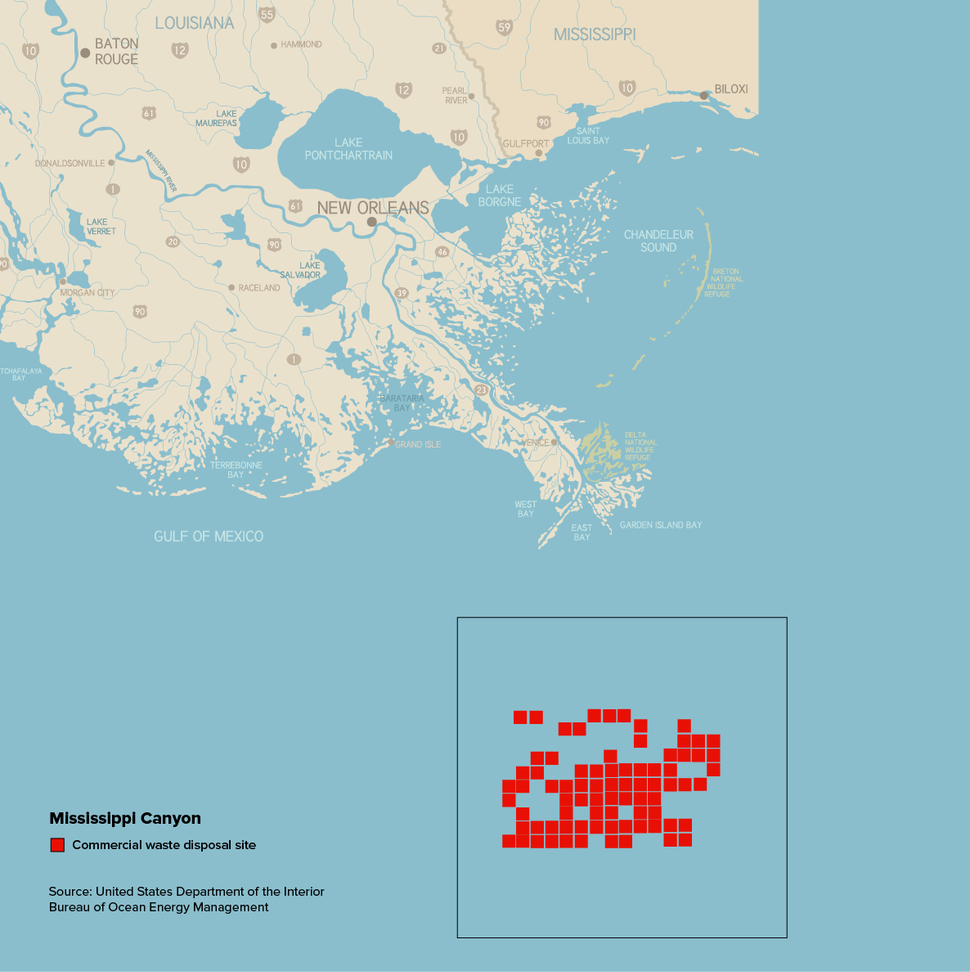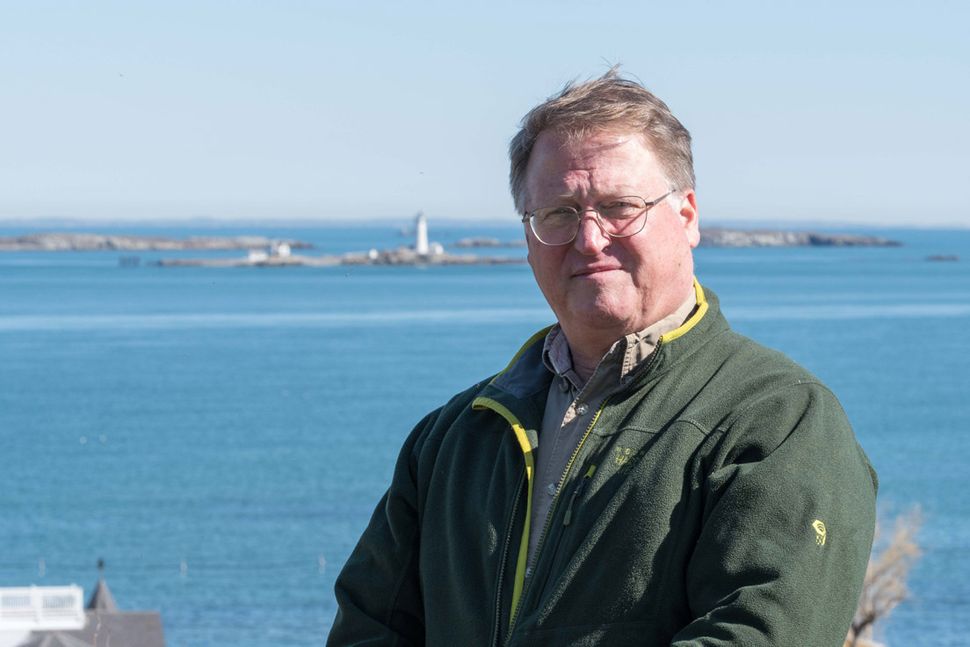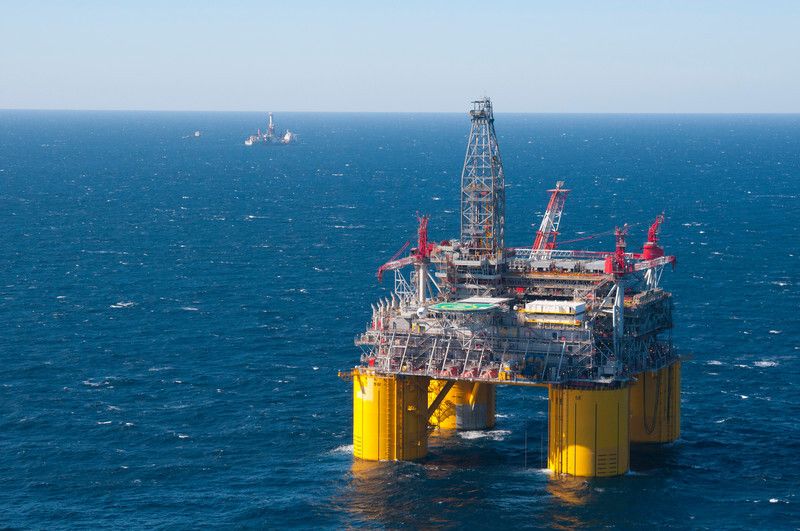Seventy miles off the coast of Louisiana, among a maze of drilling platforms and seafloor pipelines, thousands of 55-gallon drums containing hazardous industrial chemicals litter a vast, dark swath of the ocean floor. They’ve been sitting there for nearly 50 years.
Charles McCreery was a few months into a new job as an oceanographer and water quality expert at the federal Bureau of Ocean Energy Management when he first learned of the dumping ground. It was 2014, and he was tasked with reviewing oil giant Shell’s exploration plans in an offshore leasing area known as Mississippi Canyon, in the north-central Gulf of Mexico. Deep in the document, he came across the company’s internal policy for steering clear of toxic waste barrels, and what to do should their operations puncture or disturb one.
“The content, and its toxicity, of each individual barrel is not known,” the Shell document reads. “Within the area there are/could be many hundreds of waste barrels. Many of the barrels may have released their contents over time.”
The plan detailed potential hazards associated with the drums, from worker exposure while retrieving deep-sea equipment to underwater explosions. Metal salts, one of the many waste materials discarded at the site, react violently when exposed to water.
Starting in 1973, the Environmental Protection Agency issued chemical giants permits to discard thousands of drums of industrial chemical waste at the offshore site. The pollutants included chlorinated hydrocarbons, or CHCs, a family of toxic chemicals that can persist in the environment and become concentrated in marine organisms, potentially migrating up the food chain and posing a risk to human health.
In the decades since, oil companies have built up a vast network of wells and seafloor pipelines in the same portion of the Gulf. The area’s largest producer is Shell Offshore Inc., a subsidiary of oil giant Royal Dutch Shell, which operates three platform rigs and three drillships in what’s known as the Mars-Ursa oil basin. Shell also happens to be one of the companies that received permits from the EPA to dump huge quantities of industrial chemical waste in the Gulf in the 1970s, albeit at a different location.
Shell’s exploration plan ultimately led McCreery to a February 2014 notice about an upcoming auction of more than 40 million acres in the central Gulf of Mexico for oil and gas development, in which the BOEM alerted would-be bidders of the “inactive commercial waste disposal site” spanning more than 200 square miles of water south of the mouth of the Mississippi River.
The area “should be considered potentially hazardous” and “drilling and platform/pipeline placement may require precautions,” the BOEM’s notice warned. The agency noted that ocean surveys have turned up barrels as far as 10 miles from the designated dump boundary.
The barrels lie in an important domestic fishery and one of the most active offshore drilling areas on the planet. To this day, with the exception of federal officials and the energy companies drilling in the Gulf, few are aware of this legacy dumping ground.
The ocean dump would come to consume McCreery, who had worked as a geologist for Gulf Oil Co. and Chevron in the mid-1980s and for more than two decades as an environmental consultant specializing in hazardous waste remediation. He submitted public records requests to obtain EPA-issued disposal permits. He combed through company shipping logs and any government documents he could get his hands on.
McCreery wanted to know why fossil fuel exploration and extraction was being allowed on top of a field of hazardous waste and why the EPA had signed off on the dumping in the first place. More than that, he wanted to know the long-term environmental impacts, and the extent to which the federal government is studying and regulating the site — if at all.
In exchanges with HuffPost, the EPA — the agency responsible for monitoring designated offshore dumping grounds — could not point to any evidence that it kept track of the barrel field beyond the 1970s or has any understanding of the lingering effects.
A Legacy Of Deep-Blue Dumping
Throughout much of the early 20th century, the U.S. government and industry treated the ocean as a bottomless pit, too vast and too deep for human pollution to leave a mark. This policy of “out of sight, out of mind” governed a number of decisions on dumping chemical and nuclear wastes, heavy metals, military ordnance and medical waste at dozens of sites off the Pacific, Atlantic and Gulf coasts.
More than 80,000 barrels of radioactive waste are known to have been dumped at several sites in the Pacific and off the East Coast. At one location off the coast of Los Angeles, as many as half a million barrels of the potent and highly toxic insecticide DDT are scattered across the ocean floor, as a recent Los Angeles Times investigation highlighted. DDT has been banned in the U.S. since 1972, in no small part because of Rachel Carson’s book “Silent Spring,” which helped launch the modern environmental movement.
The 1972 Marine Protection, Research and Sanctuaries Act sought to bring an end to unfettered ocean dumping and better protect marine ecosystems, severely restricting what can be disposed of at sea and where. However, a section of the law granted the EPA the authority to issue special and emergency permits so long as it could prove the dumping would not “unreasonably degrade or endanger human health, welfare, or amenities, or the marine environment, ecological systems, or economic potentialities.”
In the months and years after President Richard Nixon signed the bill into law, the newly formed EPA issued multiple permits allowing companies like Shell Chemical Co., DuPont, Ethyl Corp. and GAF Corp. to dump more than 2.5 million tons of hazardous industrial waste into the Gulf, largely from the production of plastics and pesticides. A second disposal location roughly 125 miles south of Galveston, Texas, is known as Site A, and the Mississippi Canyon area is known as Site B. Both are partially detailed in a lengthy 1975 National Academy of Sciences report on ocean contaminants. HuffPost also reviewed annual EPA ocean dumping reports and EPA-issued discharge permits that McCreery obtained via public records requests.
At Site A, the EPA granted Shell Chemical five permits between 1973 and 1977 to jettison some 350,000 tons of industrial waste — approximately the weight of the Empire State Building — including hazardous chemical and heavy metal pollutants, from its manufacturing complex in Deer Park, Texas. Among the dumped CHCs were trichloropropane, a waste product of plastic production that was added to fumigants and that the EPA lists as a probable carcinogen; methyl chloroform, an ozone-depleting liquid used in solvents; and tetrachloroethylene, or PCE, a volatile and dangerous chemical used in degreasers and dry cleaning.
At that same site, the chemical giant DuPont was allowed to ditch at least 450,000 tons of industrial waste from three of its facilities, two in Texas and one in West Virginia. It dumped numerous organic and inorganic chemicals, including residues from fungicide production, arsenic, benzene and formaldehyde. GAF Corp. was permitted to dump roughly 168,000 tons of chlorinated acid compounds from the manufacture of soybean herbicide.
At Site B, in Mississippi Canyon, fuel additive company Ethyl Corp. was approved to dump approximately 19,000 barrels of waste sludge containing liquid metal salts and calcium — drums that Shell’s internal policy notes could still pose an explosive hazard. And DuPont deposited at least 1,300 barrels of waste, including “a wide variety of inorganic salts, industrial organics and chlorinated hydrocarbons” from its facility in LaPlace, Louisiana, according to the National Academy report.
That report highlights two different methods corporations used to ditch their waste. At Site A, companies did so directly into the water “through a submerged pipe into the turbulent wake of a barge,” whereas Site B was “used exclusively for materials which are placed in barrels” before being jettisoned.
McCreery reasoned that the direct discharge method at Site A likely meant there was little anyone could do about the pollution impacts at this point. But he was concerned about Site B, where fossil fuel drilling could disturb barrels and release whatever remains inside into the water column. The Mississippi Canyon barrel field is about 45 miles southwest of where BP’s Deepwater Horizon oil rig exploded in 2010, and just outside what’s known as the “fertile fisheries crescent,” an especially productive area of the northern Gulf stretching from the Texas-Louisiana border to Mobile Bay.
In a May 2016 letter to then-EPA Administrator Gina McCarthy, McCreery requested Superfund status for the Mississippi Canyon site, among other measures. He warned that waste in the drums, if released, might accumulate in the food chain and ultimately affect the food supply, a possibility that could present “an imminent and substantial danger to public health or welfare, and to the marine environment.” Adding Site B to Superfund’s National Priorities List of contaminated and hazardous sites would set in motion cleanup efforts.
Independent scientists HuffPost interviewed share McCreery’s concerns about the potential short- and long-term impacts on the environment, fisheries and even human health. Only a detailed study could unravel those impacts, but it does not appear there have been any in decades ― in no small part because most people, including scientists, have no idea these chemicals are there.
Most of the chemicals and materials listed in EPA-issued permits for the two sites are on the agency’s list of high-priority pollutants and therefore “have a range of potential detrimental effects in the environment,” said Chuck Kennicutt, an oceanographer at Texas A&M University.
“Unfortunately, we will be dealing with legacy pollution for years to come at many locations,” he said.
Chris Reddy, an environmental chemist and marine pollution expert at Woods Hole Oceanographic Institution in Massachusetts, said the substances “span a wide continuum of reactivities, potential for injury, long-term persistence and the possibility of trace amounts of highly potent chemicals of concern,” and warrant thorough scientific study.
“The scale of potential problems demands rigor,” he said.
‘It Felt Like I Was Being Ignored’
McCreery has spent five years trying unsuccessfully to get that message across to people in positions of power. Over that time, he’s developed some extraordinary theories about the sites that he’s put in writing to multiple government officials and presented at a scientific conference last year, alleging that what’s contained at the sites is far worse than what the documents disclose, and that federal regulators have conspired with industry to cover it up.
McCreery refused to sign off on Shell’s exploration plan in 2014 because he was concerned the company’s policy for avoiding seafloor barrels was not adequate. When he raised his concerns with a supervisor, he said he was told it would be a conflict of interest for him to continue work related to the barrel site, since he had already filed public records requests to the EPA as a private citizen. He recused himself from the project, though he suspected his bosses wanted to deter him from further scrutinizing the site. (The BOEM told HuffPost its policy is not to comment on personnel matters.)
A few weeks after obtaining EPA-issued permits for the two sites in May 2016, McCreery decided to take it up with McCarthy, who led the EPA for four years under President Barack Obama and now serves as President Joe Biden’s domestic climate czar. The EPA’s Office of Superfund Remediation and Technology Innovation responded to his letter two months later, informing him that it had forwarded his request to its regional office in Texas to conduct an initial risk assessment to determine if the site warranted Superfund status. Contacted for this story, EPA spokesperson Jennah Durant said the Texas office “was not able to locate a record of any response to this request,” but after HuffPost’s inquiry said it would now begin an assessment to determine appropriate next steps for the site.
The White House did not respond to a request seeking comment from McCarthy.
In his 2016 letter to McCarthy, McCreery raised concerns that the site “is the result of a discontinued disposal practice and is not adequately regulated by modern standards adopted by the EPA,” and the barrels “represent a substantial threat of release.” He also raised questions about whether the EPA even really knows what is stored at the site, based on what he called “inconsistencies” in Shell’s permits, theorizing that it could be much more hazardous waste than what was listed in the application ― waste like DDT and dioxins from Vietnam-era Agent Orange.
“People don’t just take household chemicals out to sea and dump them a mile deep,” he told HuffPost. “That indicates that the material is extremely toxic, dangerous, explosive, radioactive or something.”
McCreery is convinced that Shell jettisoned its waste not at Site A off the coast of Texas, but in Mississippi Canyon where the company is now extracting vast quantities of fossil fuels. The theory relies on a complex interpretation of the permits, company barging logs and other historical information. He goes as far as to claim that Shell altered its reports in order to obscure the waste stream, outlining what he calls “multiple lines of evidence” connecting Shell’s dumped waste to the Rocky Mountain Arsenal, the now-shuttered weapons manufacturing facility in Colorado where Shell leased a facility and produced agricultural chemicals.
Needless to say, these claims are a lot harder to substantiate than what we know to be true: that Shell and other chemical companies dumped a lot of chemicals in the Gulf 50 years ago, with the permission of the EPA, and we have very little information about what has happened in the years since.
Cynthia Babski, a Shell spokesperson, said any offshore dumping the company did in the ’70s was done in compliance with EPA permits. The dumped CHCs, she added, were “likely” liquid waste from the company’s manufacturing of vinyl chloride monomer, or VCM, a common inorganic petrochemical used to make polyvinyl chloride, a material used in PVC piping and other plastics. Vinyl chloride has been linked to several types of cancer, and the EPA has identified the production of VCM and PVC as possible sources of dioxins.
Babski did not address several questions, including to what extent, if any, Shell has monitored and studied ongoing environmental impacts.
“Shell’s top priority is the safety of our people, their families, and the communities in which we work,” Babski said.
McCreery has laid out his theory in multiple venues and continued his crusade to get more information about the sites: in a complaint to the Interior Department in 2017, to the EPA in 2018, and a report that he sent to House Oversight Committee Chair Elijah Cummings in 2019.
He says he never received any meaningful response. Interior told him it had no jurisdiction over the matter and referred his complaint to the EPA’s Office of Inspector General, according to communications he shared with HuffPost. The EPA’s watchdog ultimately referred his letter to the agency’s criminal investigations division. But much like the risk assessment it told McCreery it would conduct, the agency “does not have a record of the status of this complaint,” the EPA’s Durant said.
The House Oversight Committee did not immediately respond to a request for comment.
“It felt like I was being ignored, that my scientific concerns were being ignored,” McCreery said in one of many interviews. “I felt like I had to put my research before scientists.”
Which is how McCreery came to present his findings at a scientific conference in Tampa, Florida, in February 2020, arguing to a room of researchers that marine species in the Gulf should be tested for a range of potent CHCs, including dioxins, DDT and PCBs.
McCreery’s presentation in Tampa captivated Isabel Romero, a marine biochemist and research associate at the University of South Florida. Romero has spent years studying the effects of the Deepwater Horizon blowout and helped develop a unique method for analyzing sediment, water and fish samples for the presence of chemicals.
After McCreery’s talk, she went back to her lab and analyzed old samples from the Mississippi Canyon area, and was surprised to find molecules of DDT.
“This is not DDT in the degraded form” she said. “There has to be a present source.”
Reddy, the Woods Hole chemist, says it is entirely possible that there were impurities in the waste streams and that the dumped chemicals included more hazardous chlorinated compounds than those listed in the discharge permits. Testing capabilities, much like environmental standards, have improved drastically since the 1970s. There are also instances where certain chemicals break down into other chemicals in the environment — and that these contaminants, known as “daughter” chemicals, can be just as toxic, or even more so, than the original pollutant.
Perhaps what concerns scientists most about the Gulf sites, and the many other historic offshore dumping grounds, is how little is known about the short- and long-term impacts to fragile deep-sea ecosystems.
‘Potential Effects Have Not Been Assessed’
Before the 1972 Marine Protection act, ocean dumping was rampant. The EPA stated in its annual reports at the time that it could not immediately halt dumping altogether; the permits were meant to give companies time to find alternatives for waste disposal.
Industrial waste dumped in the Gulf declined from 1.4 million tons in 1973 to 100,000 tons in 1976, according to an EPA report to Congress dated March 1977. In Shell’s case, the alternative was to begin incinerating thousands of tons of chlorinated waste aboard a ship more than 100 miles off the coast of Texas.
Some of the dumping permits the EPA issued in the 1970s also required chemical companies to study the impacts, including whether contaminants persisted in the food chain. In December 1973, DuPont submitted to the EPA the results of its study into the impacts of its barrel dumping in Mississippi Canyon. The chemical giant reported “no long-term or short-term effects due to dumping” or “any definitive pattern that bioaccumulation has been greater inside the dumping zone than outside.”
DuPont’s study results are the only ones included in the documents McCreery obtained, and the EPA told HuffPost any additional impact reports would be archived and require additional time and resources to dig up.
Not only did the EPA permit this chemical dumping, it is tasked with surveying such sites for adverse, lingering environmental impacts. Yet the agency appears to have no better understanding of the sites today than it did in the 1970s.
“EPA is not currently monitoring these sites and has not identified monitoring that was performed since the sites were phased out,” Durant said in an email. “Potential effects have not been assessed.”
In response to several questions, Durant referred HuffPost to the initial EPA-issued permits McCreery obtained via the Freedom of Information Act and other documents from the ’70s. One document, the 1977 EPA report on offshore dumping, notes that not a single monitoring survey had been completed at either Site A or Site B, but that several “remain to be done.” Subsequent annual reports, however, appear to make no mention of surveys at the two sites, according to HuffPost’s review.
To make an informed decision about how best to deal with these dumping grounds, scientists say they must first understand what contaminants are still out there and the threat they pose. At the Mississippi Canyon site, researchers could target individual barrels for sampling. At the site off the coast of Texas, however, the method companies used to discharge liquid waste likely means contaminants rained down and blanketed a large area of the ocean floor. Seafloor sediments are often resuspended into the water column, meaning pollutants dumped decades ago in 1,000 meters of water could have migrated far downslope. Even the 1975 National Academy report notes that pollutants discharged at Site A had already reached Site B, some 400 miles to the east, and that chemical waste dumping in the Gulf and elsewhere could have regional rather than local impacts.
Meanwhile, the fossil fuel industry has been allowed to determine how best to reduce impacts to the Mississippi Canyon barrel field. In a joint response to HuffPost, the BOEM and the Interior Department’s Bureau of Safety and Environmental Enforcement said they warn lessees of the potential dangers associated with the site and require them to maintain avoidance and mitigation plans when exploring and drilling in the area, but that those plans are self-imposed. Operators are required to conduct hazard surveys before activities that disturb the seafloor and to notify the bureaus of any incidents involving barrels; to date there has not been a single reported incident of exposure or equipment damage, according to the bureaus.
“In our continuing efforts to reduce exposure risk to the men and women working offshore and to cause no further harm to the seafloor environment, BSEE and BOEM approve and enforce permits and regulations using the best available science and policy guidance,” the bureaus said.
Close Encounters
It was Shell’s avoidance policy included in the drilling plan that first tipped McCreery off to the Mississippi Canyon site. And that plan indicates the company’s extensive sonar surveying has given it a far more comprehensive understanding of the Gulf drum field than perhaps even federal agencies have.
“An unknown number of barrels still look intact, and they may or may not still contain their original content,” the plan states.
The company’s “overarching policy is to avoid barrel contact” by maintaining a 33-foot standoff distance with all equipment, according to the document. If contact is made with a drum, Shell directs workers to “use the ocean to ‘wash’ the equipment” or, if necessary, abandon it on the seafloor.
Exploration plans for the company’s deepwater projects in Mississippi Canyon include sonar maps that mark hundreds of drums spread across the seafloor, including more than a dozen within 2,000 feet of the subsea wells attached to Shell’s Olympus production platform.
Samantha Joye, an oceanographer and microbiologist at the University of Georgia, has done extensive research and sampling in the Mississippi Canyon area in the years since the 2010 Deepwater Horizon oil disaster spewed more than 200 million gallons of crude into the Gulf.
But until she saw McCreery’s presentation in Tampa last year, she’d never heard of the chemical dump site.
Joye vividly recalls encountering a 55-gallon drum during one of her many dives in Mississippi Canyon and voiced concern about what she and her colleagues might have unknowingly handled while working with marine samples. Shell’s policy of maintaining a 33-foot distance from individual drums is woefully insufficient, she argues, as drilling disturbs a large area of the seafloor.
“It is a huge environmental perturbation,” she said.
Addressing this kind of ocean pollution is not without precedent. In shallow waters east of Boston Harbor, the federal government is in the process of capping an estimated 80,000 barrels of toxic materials, including unexploded munitions and radioactive waste, with several feet of sediment dredged from the harbor, The Boston Globe reported.
Capping the Gulf dumping grounds would likely prove far more challenging and costly, given their depth and distance from land.
A research expedition would allow scientists to better understand these forgotten Gulf junkyards. New testing methods provide the capability to screen not only for certain target chemicals, but for anything and everything, including unknown and novel compounds. Some answers could lie in samples stored in freezers in university labs around the country, just waiting for a fresh look.
Reddy views such sites as living laboratories that offer the chance to learn how organisms in extreme environments respond when bombarded with hazardous materials.
“I am fascinated with how nature wins or loses in this grand chemical battle,” Reddy said.
Related
Trending
Source: Read Full Article












